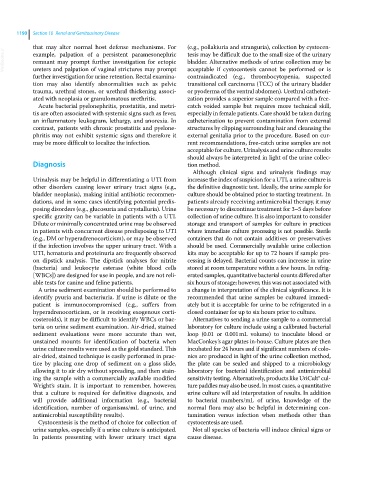Page 1252 - Clinical Small Animal Internal Medicine
P. 1252
1190 Section 10 Renal and Genitourinary Disease
that may alter normal host defense mechanisms. For (e.g., pollakiuria and stranguria), collection by cystocen-
VetBooks.ir example, palpation of a persistent paramesonephric tesis may be difficult due to the small size of the urinary
bladder. Alternative methods of urine collection may be
remnant may prompt further investigation for ectopic
ureters and palpation of vaginal strictures may prompt
contraindicated (e.g., thrombocytopenia, suspected
further investigation for urine retention. Rectal examina- acceptable if cystocentesis cannot be performed or is
tion may also identify abnormalities such as pelvic transitional cell carcinoma (TCC) of the urinary bladder
trauma, urethral stones, or urethral thickening associ- or pyoderma of the ventral abdomen). Urethral catheteri-
ated with neoplasia or granulomatous urethritis. zation provides a superior sample compared with a free‐
Acute bacterial pyelonephritis, prostatitis, and metri- catch voided sample but requires more technical skill,
tis are often associated with systemic signs such as fever, especially in female patients. Care should be taken during
an inflammatory leukogram, lethargy, and anorexia. In catheterization to prevent contamination from external
contrast, patients with chronic prostatitis and pyelone- structures by clipping surrounding hair and cleansing the
phritis may not exhibit systemic signs and therefore it external genitalia prior to the procedure. Based on cur-
may be more difficult to localize the infection. rent recommendations, free‐catch urine samples are not
acceptable for culture. Urinalysis and urine culture results
should always be interpreted in light of the urine collec-
Diagnosis tion method.
Although clinical signs and urinalysis findings may
Urinalysis may be helpful in differentiating a UTI from increase the index of suspicion for a UTI, a urine culture is
other disorders causing lower urinary tract signs (e.g., the definitive diagnostic test. Ideally, the urine sample for
bladder neoplasia), making initial antibiotic recommen- culture should be obtained prior to starting treatment. In
dations, and in some cases identifying potential predis- patients already receiving antimicrobial therapy, it may
posing disorders (e.g., glucosuria and crystalluria). Urine be necessary to discontinue treatment for 3–5 days before
specific gravity can be variable in patients with a UTI. collection of urine culture. It is also important to consider
Dilute or minimally concentrated urine may be observed storage and transport of samples for culture in practices
in patients with concurrent disease predisposing to UTI where immediate culture processing is not possible. Sterile
(e.g., DM or hyperadrenocorticism), or may be observed containers that do not contain additives or preservatives
if the infection involves the upper urinary tract. With a should be used. Commercially available urine collection
UTI, hematuria and proteinuria are frequently observed kits may be acceptable for up to 72 hours if sample pro-
on dipstick analysis. The dipstick analyses for nitrite cessing is delayed. Bacterial counts can increase in urine
(bacteria) and leukocyte esterase (white blood cells stored at room temperature within a few hours. In refrig-
[WBCs]) are designed for use in people, and are not reli- erated samples, quantitative bacterial counts differed after
able tests for canine and feline patients. six hours of storage; however, this was not associated with
A urine sediment examination should be performed to a change in interpretation of the clinical significance. It is
identify pyuria and bacteriuria. If urine is dilute or the recommended that urine samples be cultured immedi-
patient is immunocompromised (e.g., suffers from ately but it is acceptable for urine to be refrigerated in a
hyperadrenocorticism, or is receiving exogenous corti- closed container for up to six hours prior to culture.
costeroids), it may be difficult to identify WBCs or bac- Alternatives to sending a urine sample to a commercial
teria on urine sediment examination. Air‐dried, stained laboratory for culture include using a calibrated bacterial
sediment evaluations were more accurate than wet, loop (0.01 or 0.001 mL volume) to inoculate blood or
unstained mounts for identification of bacteria when MacConkey’s agar plates in‐house. Culture plates are then
urine culture results were used as the gold standard. This incubated for 24 hours and if significant numbers of colo-
air‐dried, stained technique is easily performed in prac- nies are produced in light of the urine collection method,
tice by placing one drop of sediment on a glass slide, the plate can be sealed and shipped to a microbiology
allowing it to air dry without spreading, and then stain- laboratory for bacterial identification and antimicrobial
ing the sample with a commercially available modified sensitivity testing. Alternatively, products like UriCult® cul-
Wright’s stain. It is important to remember, however, ture paddles may also be used. In most cases, a quantitative
that a culture is required for definitive diagnosis, and urine culture will aid interpretation of results. In addition
will provide additional information (e.g., bacterial to bacterial numbers/mL of urine, knowledge of the
identification, number of organisms/mL of urine, and normal flora may also be helpful in determining con-
antimicrobial susceptibility results). tamination versus infection when methods other than
Cystocentesis is the method of choice for collection of cystocentesis are used.
urine samples, especially if a urine culture is anticipated. Not all species of bacteria will induce clinical signs or
In patients presenting with lower urinary tract signs cause disease.

